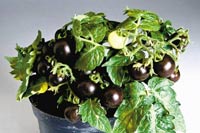|
|

|
|
A purple tomato genetically engineered to contain nutrients more commonly seen in dark berries helped prevent cancer in mice, British researchers said on Sunday.
|
A purple tomato genetically engineered to contain nutrients more commonly seen in dark berries helped prevent cancer in mice, British researchers said on Sunday.
The finding, published in the journal Nature Biotechnology, bolsters the idea that plants can be genetically modified to make people healthier.
Cancer-prone mice fed the modified fruit lived significantly longer than animals fed a standard diet with and without regular tomatoes, Cathie Martin and colleagues at the government-funded John Innes Center in Britain reported.
"The effect was much bigger than we had expected," said Martin, a plant biologist.
The study focused on anthocyanins, a type of antioxidant found in berries such as blackberries and blackcurrants that have been shown to lower risk of cancer, heart disease and some neurological diseases.
While an easy health boost, many people do not eat enough of these fruits, the researchers said.
Using genes that help color the snapdragon flower, the researchers discovered they could get the tomatoes to make anthocyanins -- turning the tomato purple in the process.
Mice genetically engineered to develop cancer lived an average of 182 days when they were fed the purple tomatoes, compared to 142 days for animals on the standard diet.
"It is enormously encouraging to believe that by changing diet, or specific components in the diet, you can improve health in animals and possibly humans," Martin said in a telephone interview.
The researchers cautioned that trials in humans are a long way off and the next step is to investigate how the antioxidants actually affect the tumors to promote better health.
But the findings do bolster research suggesting that people can significantly improve their health by making simple changes to the daily diet, other researchers said.
"It's exciting to see new techniques that could potentially make healthy foods even better for us," said Dr. Lara Bennett, science information officer at Cancer Research UK.
"But it's too early to say whether anthocyanins obtained through diet could help to reduce the risk of cancer."
點(diǎn)擊查看更多雙語(yǔ)新聞
(Agencies)
|
英國(guó)研究人員于上周日稱(chēng),一種轉(zhuǎn)基因紫番茄富含黑漿果中常見(jiàn)的營(yíng)養(yǎng)成分,可以防止老鼠體內(nèi)的癌細(xì)胞蔓延。
這項(xiàng)研究結(jié)果在《自然生物工藝學(xué)》期刊上發(fā)表,支持了轉(zhuǎn)基因植物能夠促進(jìn)人類(lèi)健康這種理論。
英國(guó)政府資助的約翰?英納斯研究中心的植物學(xué)家凱西?馬丁及其同事們稱(chēng),有患癌傾向的老鼠食用這種轉(zhuǎn)基因西紅柿后,壽命明顯長(zhǎng)于吃普通食物的同類(lèi)老鼠。
馬丁說(shuō):“這種西紅柿的功效遠(yuǎn)遠(yuǎn)超出了我們的預(yù)期。”
該研究的主要對(duì)象是黑莓和黑醋栗等漿果中富含的一種抗氧化物質(zhì)——花青素。研究表明,花青素能夠降低患癌癥、心臟病和其他一些神經(jīng)系統(tǒng)疾病的風(fēng)險(xiǎn)。
研究人員稱(chēng),這種促進(jìn)健康的方法簡(jiǎn)單易行,但人們卻很少吃這些水果。
研究人員從金魚(yú)草的花朵中提取了可產(chǎn)生花青素的基因,然后將其轉(zhuǎn)移至普通西紅柿中,就培育出了紫色的番茄。
研究人員利用轉(zhuǎn)基因技術(shù),讓兩組老鼠患上癌癥,結(jié)果證明,食用紫番茄的老鼠平均存活182天,食用標(biāo)準(zhǔn)食物的老鼠平均壽命為142天。
馬丁在電話采訪中說(shuō):“這讓我們深受鼓舞,我們相信通過(guò)改變飲食或飲食中的特定成分能夠促進(jìn)動(dòng)物乃至人類(lèi)的健康。”
一些研究者警告說(shuō),以人類(lèi)為實(shí)驗(yàn)對(duì)象為時(shí)尚早,下一步的工作是要研究花青素是如何抑制腫瘤、促進(jìn)健康的。
另有一些研究者認(rèn)為,這一發(fā)現(xiàn)進(jìn)一步證實(shí)了此前的研究成果,即人們可以通過(guò)改變?nèi)粘o嬍硜?lái)改善健康。
英國(guó)癌癥研究所的科學(xué)信息員萊拉?貝內(nèi)特說(shuō):“很高興看到新科技能為我們帶來(lái)更健康的食品。”
“但目前判定通過(guò)飲食攝取的花青素能否降低患癌幾率還為時(shí)尚早。”
(實(shí)習(xí)生瞿漫 英語(yǔ)點(diǎn)津姍姍編輯)
|